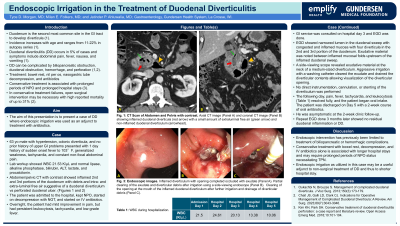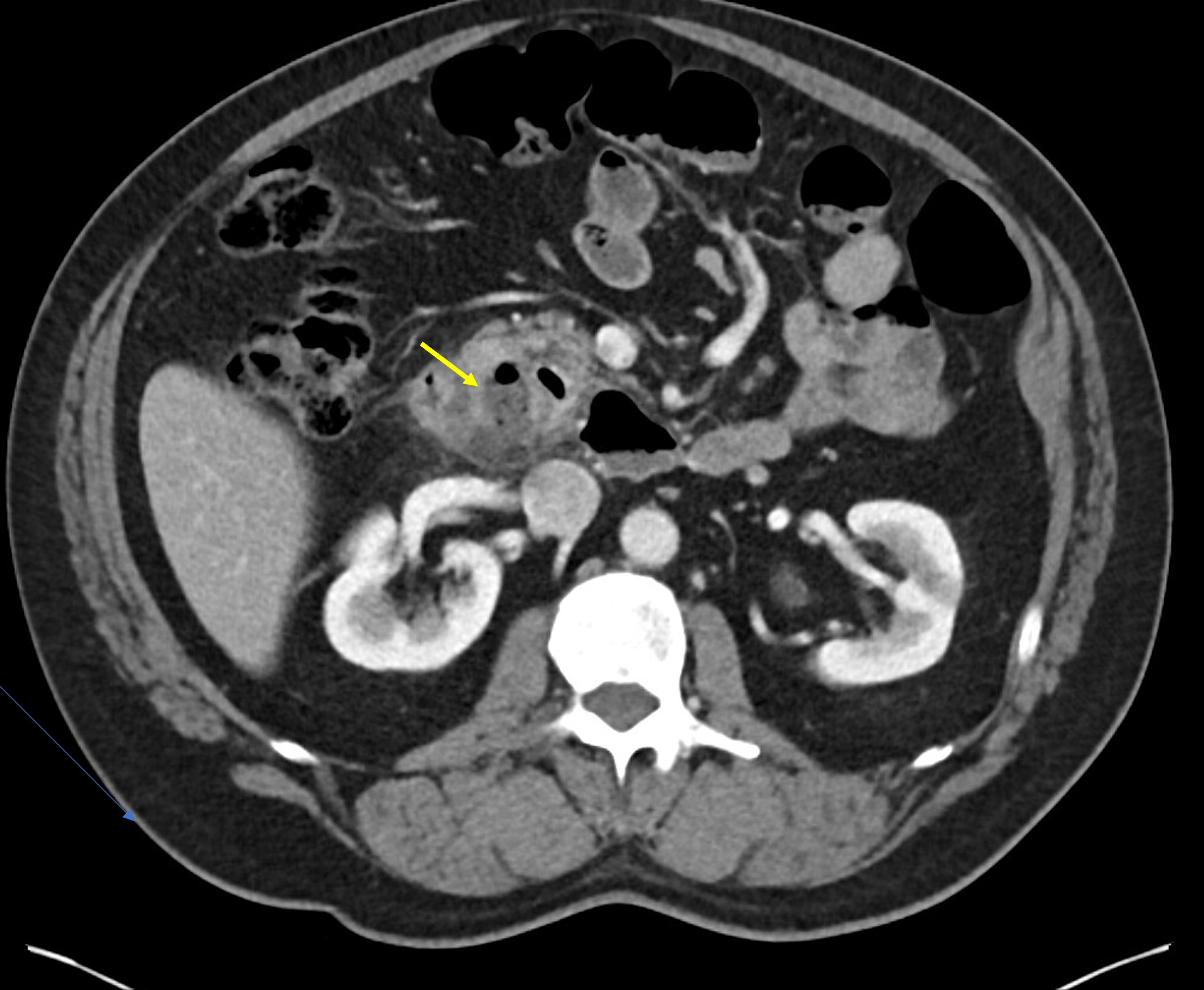Monday Poster Session
Category: Small Intestine
P3278 - Endoscopic Irrigation in the Treatment of Duodenal Diverticulitis
Monday, October 28, 2024
10:30 AM - 4:00 PM ET
Location: Exhibit Hall E

Has Audio
- TM
Tyce D. Morgan, MD
Gundersen Health Systems
La Crosse, WI
Presenting Author(s)
Tyce D. Morgan, MD1, Milan Folkers, MD2, Jatinder P. Ahluwalia, MD2
1Gundersen Health Systems, La Crosse, WI; 2Emplify Health, La Crosse, WI
Introduction: Duodenal diverticulosis is relatively common but is asymptomatic in 95% of cases. However, symptomatic duodenal diverticulitis (DD) can lead to complications such as biliopancreatic obstruction, duodenal obstruction, bleeding, and perforation. We describe a case of symptomatic DD treated initially with bowel rest and antibiotics with prompt resolution of symptoms following endoscopic treatment.
Case Description/Methods: A 63-year-old man with hypertension and colonic diverticula presented to the ER with one day history of sudden onset of fever to 103°F, generalized weakness, and constant non-focal abdominal pain. Labs showed leukocytosis with WBCs 21.53 K/uL and was otherwise unremarkable. Abdomen/pelvic CT with contrast showed inflammatory changes in the second and third portions of the duodenum along with air and debris suggesting a duodenal diverticulum, perforated duodenal ulcer, versus an abscess. He was diagnosed with DD, admitted to the surgical service, made NPO with nasogastric tube decompression, and started on IV antibiotics. UGI contrast study showed significant narrowing of the second portion of duodenum felt to be related to external compression with slow and intermittent contrast flow through this area. He had mild improvement in abdominal pain but had persistent leukocytosis, tachycardia up to 130 bpm, and temperatures up to 100°F. EGD on day 3 showed narrowed lumen in the duodenal sweep with severely inflamed mucosa around a diverticulum with exudative material between inflamed mucosal folds just upstream of the duodenal sweep. A side-viewing endoscope showed exudative material at the neck of a diverticulum. Aggressive irrigation with a washing catheter resulted in expulsion of exudate and debris with good drainage of diverticular contents. His symptoms and leukocytosis resolved the next day and he was advanced to a liquid diet. He was discharged to home on oral antibiotics on day 5 to complete a total of 2 weeks course. He reported no symptoms on follow-up 2 weeks after hospital discharge.
Discussion: Duodenal diverticula are rarely symptomatic and DD occurs in 1-5% of cases. Previous reports of treatment with NPO and antibiotics alone have shown prolonged hospital stays. In addition to antibiotics and keeping patients NPO, various endoscopic techniques have been described but involve instrumentation and stenting of the diverticula. We describe a case of DD treated successfully with antibiotics along with minimal endoscopic intervention leading to rapid clinical improvement.

Disclosures:
Tyce D. Morgan, MD1, Milan Folkers, MD2, Jatinder P. Ahluwalia, MD2. P3278 - Endoscopic Irrigation in the Treatment of Duodenal Diverticulitis, ACG 2024 Annual Scientific Meeting Abstracts. Philadelphia, PA: American College of Gastroenterology.
1Gundersen Health Systems, La Crosse, WI; 2Emplify Health, La Crosse, WI
Introduction: Duodenal diverticulosis is relatively common but is asymptomatic in 95% of cases. However, symptomatic duodenal diverticulitis (DD) can lead to complications such as biliopancreatic obstruction, duodenal obstruction, bleeding, and perforation. We describe a case of symptomatic DD treated initially with bowel rest and antibiotics with prompt resolution of symptoms following endoscopic treatment.
Case Description/Methods: A 63-year-old man with hypertension and colonic diverticula presented to the ER with one day history of sudden onset of fever to 103°F, generalized weakness, and constant non-focal abdominal pain. Labs showed leukocytosis with WBCs 21.53 K/uL and was otherwise unremarkable. Abdomen/pelvic CT with contrast showed inflammatory changes in the second and third portions of the duodenum along with air and debris suggesting a duodenal diverticulum, perforated duodenal ulcer, versus an abscess. He was diagnosed with DD, admitted to the surgical service, made NPO with nasogastric tube decompression, and started on IV antibiotics. UGI contrast study showed significant narrowing of the second portion of duodenum felt to be related to external compression with slow and intermittent contrast flow through this area. He had mild improvement in abdominal pain but had persistent leukocytosis, tachycardia up to 130 bpm, and temperatures up to 100°F. EGD on day 3 showed narrowed lumen in the duodenal sweep with severely inflamed mucosa around a diverticulum with exudative material between inflamed mucosal folds just upstream of the duodenal sweep. A side-viewing endoscope showed exudative material at the neck of a diverticulum. Aggressive irrigation with a washing catheter resulted in expulsion of exudate and debris with good drainage of diverticular contents. His symptoms and leukocytosis resolved the next day and he was advanced to a liquid diet. He was discharged to home on oral antibiotics on day 5 to complete a total of 2 weeks course. He reported no symptoms on follow-up 2 weeks after hospital discharge.
Discussion: Duodenal diverticula are rarely symptomatic and DD occurs in 1-5% of cases. Previous reports of treatment with NPO and antibiotics alone have shown prolonged hospital stays. In addition to antibiotics and keeping patients NPO, various endoscopic techniques have been described but involve instrumentation and stenting of the diverticula. We describe a case of DD treated successfully with antibiotics along with minimal endoscopic intervention leading to rapid clinical improvement.

Figure: Abdominal CT scan showing marked inflammation in the duodenum (arrow) along with duodenal diverticula
Disclosures:
Tyce Morgan indicated no relevant financial relationships.
Milan Folkers indicated no relevant financial relationships.
Jatinder Ahluwalia indicated no relevant financial relationships.
Tyce D. Morgan, MD1, Milan Folkers, MD2, Jatinder P. Ahluwalia, MD2. P3278 - Endoscopic Irrigation in the Treatment of Duodenal Diverticulitis, ACG 2024 Annual Scientific Meeting Abstracts. Philadelphia, PA: American College of Gastroenterology.
